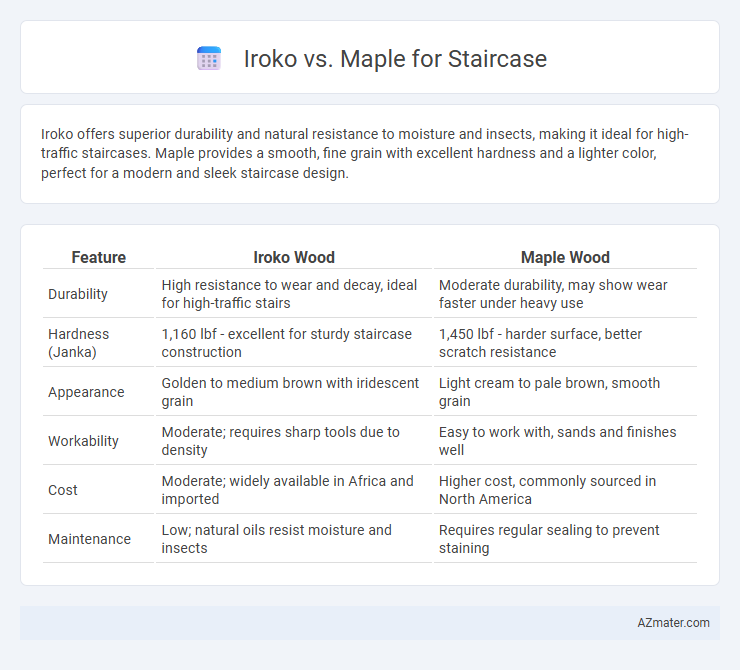Iroko offers superior durability and natural resistance to moisture and insects, making it ideal for high-traffic staircases. Maple provides a smooth, fine grain with excellent hardness and a lighter color, perfect for a modern and sleek staircase design.
Table of Comparison
| Feature | Iroko Wood | Maple Wood |
|---|---|---|
| Durability | High resistance to wear and decay, ideal for high-traffic stairs | Moderate durability, may show wear faster under heavy use |
| Hardness (Janka) | 1,160 lbf - excellent for sturdy staircase construction | 1,450 lbf - harder surface, better scratch resistance |
| Appearance | Golden to medium brown with iridescent grain | Light cream to pale brown, smooth grain |
| Workability | Moderate; requires sharp tools due to density | Easy to work with, sands and finishes well |
| Cost | Moderate; widely available in Africa and imported | Higher cost, commonly sourced in North America |
| Maintenance | Low; natural oils resist moisture and insects | Requires regular sealing to prevent staining |
Introduction to Iroko and Maple as Staircase Materials
Iroko, a durable hardwood native to West Africa, is prized for its rich golden to medium brown tones and high resistance to moisture and decay, making it ideal for staircase construction in both interior and exterior settings. Maple, a dense, fine-grained hardwood from North America, offers a smooth surface and pale creamy color that can be easily stained or finished to suit various design styles, providing excellent strength and wear resistance for staircases with heavy foot traffic. Both woods are favored for their hardness and longevity, but Iroko's natural oils enhance its durability against environmental factors, whereas Maple's consistent grain allows for a more refined, contemporary aesthetic.
Key Characteristics of Iroko Wood
Iroko wood is highly valued for its durability, natural resistance to rot and insects, making it an excellent choice for staircase construction in both indoor and outdoor environments. Its rich, golden to medium brown color darkens with age, providing an attractive aesthetic that rivals traditional hardwoods like teak. The coarse grain and oily texture contribute to its strength and ease of maintenance, while its stability minimizes warping and shrinkage under varying humidity conditions.
Distinctive Features of Maple Wood
Maple wood is renowned for its exceptional hardness and fine, uniform grain, making it highly durable and resistant to dents and scratches, ideal for high-traffic staircase areas. Its light color with subtle grain patterns offers a sleek, contemporary aesthetic that brightens interior spaces and complements various decor styles. Maple also takes stain very evenly, allowing for versatile finishing options that can mimic more expensive hardwoods or maintain a natural, clean look.
Durability Comparison: Iroko vs Maple
Iroko wood offers superior durability for staircases due to its high resistance to wear, moisture, and insect damage, making it ideal for high-traffic areas. Maple, while hard and dense, is less resistant to moisture and prone to denting over time, which can compromise its longevity on stairs. For long-lasting staircase applications, Iroko's natural oils and tougher grain structure provide enhanced strength and durability compared to Maple.
Aesthetic Appeal: Color and Grain Differences
Iroko wood offers a rich golden to medium brown color with a coarse, interlocking grain that creates a bold, textured appearance ideal for staircases seeking a warm, organic look. Maple features a lighter, creamy white to pale reddish-brown hue with a smooth, even grain, providing a sleek and modern aesthetic that brightens interior spaces. Choosing between Iroko and Maple for staircases depends on the desired contrast and warmth, with Iroko enhancing rustic elegance and Maple supporting minimalist designs.
Maintenance Needs: Iroko vs Maple Staircases
Iroko staircases require less frequent maintenance due to their natural resistance to moisture, decay, and insect damage, making them ideal for high-traffic or humid environments. Maple staircases, while visually appealing with their fine, uniform grain, demand regular sealing and polishing to prevent surface wear and maintain their durability. Choosing Iroko reduces long-term upkeep costs, whereas Maple necessitates consistent care to preserve its aesthetic and structural integrity.
Cost Analysis and Budget Considerations
Iroko wood, known for its durability and rich, golden-brown hue, typically costs between $6 to $10 per board foot, making it a mid-range option for staircase projects. Maple, a hardwood with a fine, uniform texture and light color, generally ranges from $5 to $9 per board foot, often preferred for its smooth finish and workability. When budgeting for a staircase, factoring in Iroko's slightly higher price due to its natural resistance to wear and decay versus Maple's more affordable cost and versatile aesthetics helps optimize material expenditure without compromising quality.
Performance in Different Climates
Iroko wood offers exceptional durability and natural resistance to moisture, making it ideal for staircases in humid or tropical climates. Maple, known for its hardness and fine grain, performs well in stable, dry indoor environments but may be more prone to warping or shrinking with high humidity fluctuations. Choosing between Iroko and Maple depends on climate conditions, as Iroko handles moisture variations better while Maple excels in controlled interior settings.
Sustainability and Environmental Impact
Iroko wood, renowned for its durability, is sustainably harvested in West African forests with regulated replanting practices, reducing environmental degradation compared to non-certified sources. Maple, often sourced from North American forests with established sustainability certifications, boasts rapid growth and efficient regeneration, minimizing deforestation impact. Choosing FSC-certified Iroko or Maple ensures reduced carbon footprint and supports responsible forestry, making both viable eco-friendly options for staircase construction.
Choosing the Best Wood: Iroko or Maple for Your Staircase
Iroko offers exceptional durability and natural resistance to moisture and decay, making it ideal for high-traffic staircases requiring long-lasting strength. Maple provides a smooth, fine grain and lighter color, perfect for modern and elegant staircase designs with excellent hardness for wear resistance. Selecting between Iroko and Maple depends on your preference for color, grain, and environmental durability to ensure a staircase that combines beauty with functionality.

Infographic: Iroko vs Maple for Staircase
 azmater.com
azmater.com